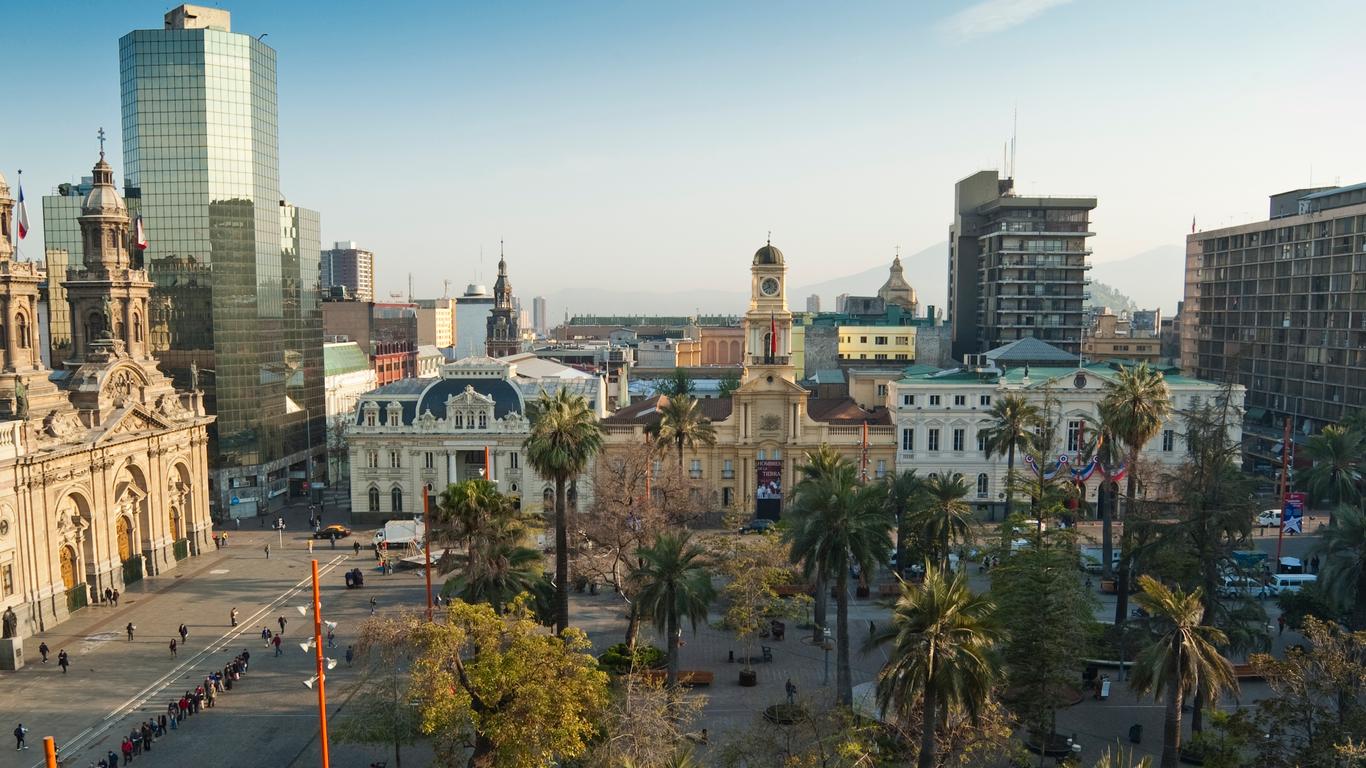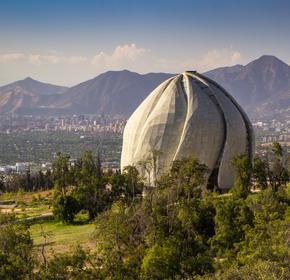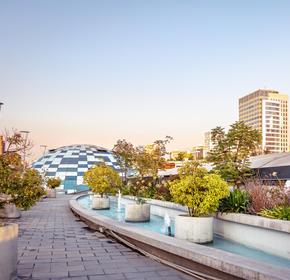
Santiago travel guide
Santiago Tourism | Santiago Guide
You're Going to Love Santiago
Santiago is the capital city of Chile and both its cultural and economic center. It has a great calendar of events and buzzes with theaters, restaurants, and bars. Situated in the middle of the country, it also provides a great base from which to explore the stunning landscapes of Chile.

Santiago is situated between the mountains and the sea. This means that in a single day of your visit, you can enjoy skiing in the Andes in the morning and then sunbathe on the Pacific coast in the afternoon.
This is a city of lush urban parks, fascinating museums, and the most impressive city skyline in South America. Chile is also alive with history, and when you are finished seeing the sights, you can enjoy some of the best nightlife on the continent.
Top 5 Reasons to Visit Santiago
1. Plaza De Armas
The Plaza De Armas is the main square in the city and a great place to get a feel for its culture and atmosphere. You will find the National Cathedral here, along with a Peruvian community, which has established a plethora of cheap and interesting places to eat, food stores, and spice stalls.
2. Parque Metropolitano
This huge park is home to the Cerro San Cristobal, two swimming pools, a zoo, and a botanical garden. Take the cable car to the top for one of the best views of the city. On a clear day you can also see all the way to the Andes.
3. Sky Costanera
The Sky Costanera is a viewing deck on top of the tallest building anywhere in South America, the Gran Torre Santiago. There are both indoor and outdoor observation decks, which provide more great views of the city.
4. Mercado Central
The central market was built in 1872 and still operates as Santiago's main market today, with lots of stalls selling fresh local produce; delicious seafood is a specialty. It has a thriving atmosphere, with bars and lots of restaurants featuring all that produce. It's a great place for a stroll, even if you don't intend to buy anything.
5. Jazz Clubs
There is a vibrant jazz scene in Santiago, with lots of clubs, the best being perhaps the Club de Jazz de Santiago to the north of the city in the Nunoa district. The club attracts musicians from all over the world.
What to do in Santiago
1. Santuario del Cerro San Cristóbal: A Sanctuary Three Thousand Feet Above Sea Level
This icon of Santiago holds more than just the chapel for Catholic worship in Chile. It is the home of the 45-foot-tall statue of the Immaculate Conception, itself resting some 2,831 feet above sea level. Come during the day to marvel at its magnificence under blue skies or at night, when the whole area is aglow with twinkling night lights. To journey up, take the Santiago Cable Car and rest for a spell at the large ampitheatre, where religious ceremonies are held. The road to Immaculate Conception adjoins the Santiago Metropolitan Park.
2. Museo de la Memoria y los Derechos Humanos: Lest We Forget
Don't let its shimmering glass facade fool you: inside, the atrocities and "disappearances" in Chile's recent tumultuous history are captured as a memory and warning. Its name, after all, is translated as, "The Museum of Memory and Human Rights". The brutal civic-military regime of Pinochet claimed the lives of many Chileans and the museum features permanent exhibits of moving letters from prisoners to their loved ones, torture devices, detention centers, media coverage and clippings, and the art that was created in response to this regrettable epoch. For a sobering and philosophical afternoon, this museum is a must.
3. Sky Costanera: The View From Up Here
The "Gran Torre Santiago" or "The Great Tower of Santiago" is a skyscraper that runs 64 stories tall. As part of the Costanera Center, which has the largest shopping mall in Latin America, the Sky Costanera is where viewers can observe a 360-degree view of Santiago.
4. Plaza de Armas: The Main Square
The main square of Santiago is laid out in a square grid-like pattern and holds some of its most historical buildings. There is much colonial architecture and beauty to be found. Traditionally, the "Plaza de Armas" in Hispanic and Latin American cities are the central hub of its politics and commerce. Here, too, rests the seat of the local government of Santiago, its Metropolitan Cathedral, and the Chilean National History Museum, sitting cozily in the Palacio de la Real Audiencia de Santiago. This majestic building is also home to Santiago's Congress and used to serve as the royal courts of justice.
5. Bellavista: The Bohemian Barrio
Nestled between the Mapocho River and San Cristóbal Hill is this trendy "barrio" or neighborhood, with all kinds of hip restaurants and up-and-coming new boutiques. Travelers who want a taste of the art and food scenes in Santiago will delight in the myriad of galleries and well-designed buildings cropping up, as well as the avante-garde eateries, dedicated to getting experimental with local ingredients. Even a simple stroll down its streets are sure to give you a wonderful insight into the lives of Chilean intellectuals and artists, such as the beloved Pablo Neruda. In the evenings, the steady stream of music pours through the streets from Bellavista's numerous bars and discos. This is where the heartbeat of Santiago lies.




1. Santuario del Cerro San Cristóbal: A Sanctuary Three Thousand Feet Above Sea Level
This icon of Santiago holds more than just the chapel for Catholic worship in Chile. It is the home of the 45-foot-tall statue of the Immaculate Conception, itself resting some 2,831 feet above sea level. Come during the day to marvel at its magnificence under blue skies or at night, when the whole area is aglow with twinkling night lights. To journey up, take the Santiago Cable Car and rest for a spell at the large ampitheatre, where religious ceremonies are held. The road to Immaculate Conception adjoins the Santiago Metropolitan Park.
2. Museo de la Memoria y los Derechos Humanos: Lest We Forget
Don't let its shimmering glass facade fool you: inside, the atrocities and "disappearances" in Chile's recent tumultuous history are captured as a memory and warning. Its name, after all, is translated as, "The Museum of Memory and Human Rights". The brutal civic-military regime of Pinochet claimed the lives of many Chileans and the museum features permanent exhibits of moving letters from prisoners to their loved ones, torture devices, detention centers, media coverage and clippings, and the art that was created in response to this regrettable epoch. For a sobering and philosophical afternoon, this museum is a must.
3. Sky Costanera: The View From Up Here
The "Gran Torre Santiago" or "The Great Tower of Santiago" is a skyscraper that runs 64 stories tall. As part of the Costanera Center, which has the largest shopping mall in Latin America, the Sky Costanera is where viewers can observe a 360-degree view of Santiago.
4. Plaza de Armas: The Main Square
The main square of Santiago is laid out in a square grid-like pattern and holds some of its most historical buildings. There is much colonial architecture and beauty to be found. Traditionally, the "Plaza de Armas" in Hispanic and Latin American cities are the central hub of its politics and commerce. Here, too, rests the seat of the local government of Santiago, its Metropolitan Cathedral, and the Chilean National History Museum, sitting cozily in the Palacio de la Real Audiencia de Santiago. This majestic building is also home to Santiago's Congress and used to serve as the royal courts of justice.
5. Bellavista: The Bohemian Barrio
Nestled between the Mapocho River and San Cristóbal Hill is this trendy "barrio" or neighborhood, with all kinds of hip restaurants and up-and-coming new boutiques. Travelers who want a taste of the art and food scenes in Santiago will delight in the myriad of galleries and well-designed buildings cropping up, as well as the avante-garde eateries, dedicated to getting experimental with local ingredients. Even a simple stroll down its streets are sure to give you a wonderful insight into the lives of Chilean intellectuals and artists, such as the beloved Pablo Neruda. In the evenings, the steady stream of music pours through the streets from Bellavista's numerous bars and discos. This is where the heartbeat of Santiago lies.




Where to Eat in Santiago
Amadeus on Avenida General Bustamante serves tasty wood-fired pizzas from CLP$3,500. Restaurant Cruz Coke on Pasaje Doctor Eduardo Cruz Coke, has a good range of local food and an excellent wine list, with mains from CLP$7,000.
When to visit Santiago
Santiago enjoys a temperate climate, with warm dry summers and mild winters. Summer temperatures can reach 95 degrees Fahrenheit, while winter temperatures can drop to freezing. This makes both spring and fall ideal for a visit to the city for those trying to avoid those temperature extremes.
How to Get to Santiago
Plane
Santiago Airport (SCL) is the main airport, and has international connections to Dallas, Miami, Atlanta, Miami, New York, and Los Angeles. There are also services to other South American cities and internal regional flights. Bus connections run every 10 minutes into the city center, charging CLP$1,700 for a one-way trip. There is also a hotel shuttle service that will take you directly to your accommodation for CLP$6,500. A taxi ride into the center will cost around CLP$15,000.
Train
Train services to Santiago are extremely limited. The main line runs 155 miles south to Talca, and there is a light rail service called Metrotren running frequent daily services to Rancagua and San Fernando. A single fare to Talca costs CLP$6,600.
Car
Roads in Chile are fairly good and traffic problems are rare. Route 5 is the main north to south road and Route 68 will take you west to the coast at Valparaiso. Entering Santiago on the Autopista Central, you will need to buy a TAG toll transponder, which are available at gas stations. You can buy one after entering the toll network; they cost CLP$4,400 per day. Rental cars should already be fitted with a transponder.
Bus
Santiago is served by an extensive bus network, with services across South America. The main bus stations are located at Terminal Alameda and Terminal Santiago. Alameda serves the Turbus and Pullman buses and most of the international routes. Both stations are adjacent to the Universidad de Santiago train station. A single fare to Mendoza, Argentina will cost CLP$17,000 and a ticket to Lima, Peru is CLP$85,000.
Airports near Santiago
Airlines serving Santiago
Where to stay in Santiago
Providencia - this is an upscale area with lots of good accommodation. It has some good shopping on Avenida Nueva Providencia, excellent Italian restaurants, and the Teatro Oriente to catch some shows.
Popular Neighborhoods in Santiago
Bellavista - this is the center of Santiago's nightlife scene. Bars and clubs are plentiful, including the unusual Kitemate bar run by people from Easter Island. There are lots of street artists to enjoy, and Cerro San Cristobal and the zoo are nearby.
Lastarria - this is a charming neighborhood of European-inspired architecture and cobbled streets. It is home to the Museum of Visual Arts and has a slightly bohemian feel.
Where to stay in popular areas of Santiago
Most booked hotels in Santiago
How to Get Around Santiago
Public Transportation
Santiago has an extensive subway (metro) system and a huge bus network. To use the buses, you will need to buy a Bip! Card. This also works on the subway and is a convenient way to get around. The card is available from any station and costs CLP$1,350 with a minimum fare charge of another CLP$1,000. A typical subway or bus fare is CLP$720.
Taxi
There are lots of taxis all across Santiago, and all official taxis are black with yellow roofs. The starting fare is CLP$250 and you will then be charged around CLP$900 per mile of your journey.
Car
Santiago's road network is generally well maintained, and the city has few traffic problems. Renting a car is a good option if you want to head out to ski in the Andes of take a tour of the wine country. Car rental is widely available from companies like Avis and Sixt, and prices start at CLP$32,000 per day.
The Cost of Living in Santiago
Shopping Streets
Santiago has a wide selection of malls, the largest being Alto Las Condes and Parque Arauco. You will find a huge variety of stores selling fashion, consumer goods, electronics, and housewares. For high-end fashion, head to Alonso de Córdova Street. Local crafts can be bought at Centro Artesanal Santa Lucia.
Groceries and Other
You will pay around CLP$762 for a quart of milk in Santiago, while a dozen eggs will cost CLP$2,187. Major supermarkets include Santa Isabel and Jumbo Bilbao.


